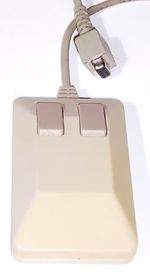Mouse
The mouse is an input-device and is mainly used for navigation on graphical user interfaces (GUI), but also in computer games and applications. Whereas for the C64 there are only few applications where the mouse can be reasonably used, it has found its place next to the keyboard on computer systems PC and MAC as an input-device.
Contents
[hide]Preface[edit]
The conventional computer mouse was developed at the beginning of the 80's and consists of a running ball in a handy housing. With sensors the movement of the ball in x and y direction is measured and signaled to the computer. The corresponding programs then process this signal and e.g. place the pointer on the right position in the screen. For a consistent operation, a smooth surface underneath the mouse was created by placing the mouse on an anti-static mouse pad.
Additionally computer mice have one, two or more functional buttons, sometimes an additional mouse wheel for easier reading of long texts on the screen. A standard conventional computer mouse has two buttons on the top, one left and one right whereas the left button is usually used for navigation, marking or selection of menu items. Since the 90's the usage of the right button for the context menu has been established. Nowadays the configuration of additional buttons can be set by using the mouse driver.
The development of computer mice has proceeded, so there are more models, which not only use the serial or parallel interface of the PC, but also can be connected by the PS/2, USB, firewire or bluetooth port.
Furthermore the computer mouse became more independent by the use of radio transmission and the maintenance requirements (cleaning and/or wearout of the ball) were diminished by the use of optical techniques for positioning.
The mouse and the C64[edit]
With the C64 PC-computer mouse were connected over the serial interface or the userport, by a corresponding interface card. The usage of the controlports was rare, there is a special adapter for this Micromys ![]() .
.
Mouse especially made for the C64 were by default connected to the controlport. Basically there are two different types of mouse with the C64. The difference can be found in the operation method and the interface respectively.
Digital - joystick mode
With the so-called joystick mouse the mouse movements are converted into the signals of a digital joystick, that means the movements are transformed so they resemble movements of a digital joystick. In fact, with this only simple horizontal, vertical and 45° diagonal movements can be made, but in return the mouse can be used for programs which are designed to be used with a joystick. The speed cannot be detected, the mouse pointer only moves with the speed that is defined by the program.
- Mouse 1350 by Commodore
- Mouse M1 by NORIS DATA
- Geos-Mouse by Boeder
- Elite Mouse
- Mouse SV-705 by Datalux
- DELA-Maus
- Turbo Geos Mouse
Analogue - proportional mode
The advantages of an analogue mouse are the detection of the movement speed and the "position" of the mouse. Normally with this mouse two buttons can be queried independently from each other. The signals are similar to the paddles processed by two A/D-converters of the soundchip. The analogue mouse is most suitable for GEOS, but also some games support it.
- Mouse 1351 by Commodore
- SmartMouse by CMD (Creative Micro Designs) Review

- Clever Mouse 1
- NEOS Mouse (not 1531 compatible)
- M3 Mouse from Contriver Tech. Inc.
- Micromys, originally by Marko Herold, later Individual Computers Ltd.
Others:
- GEES-SMARTMOUSE
- GEOS Mouse Set (incl. mouse holder) from Office Data / Dynamic Data
- Magic Mouse by Connexions/SMC Supplies
- Mighty Mouse
- Scanntronik Maus
- POWERclick mouse (version for C64-/C128)
- TORTOISE Mouse
- Turbo Mouse (3 buttons)
Pin configuration:
| Pin | Joystick mode | Proportional mode | Micromys mode | Atari | Amiga |
|---|---|---|---|---|---|
| 1 | Up | right button | right button | XB | YA (V-pulse) |
| 2 | Down | not used | middle button | XA | XA (H-pulse) |
| 3 | Left | not used | wheel up | YA | YB (VQ-pulse) |
| 4 | Right | not used | wheel down | YB | XB (HQ-pulse) |
| 5 | not used | y-position | y-position | NC | MBUT |
| 6 | Left button | left button | left button | LBUT | LBUT |
| 7 | + 5V | + 5V | + 5V | + 5V | + 5V |
| 8 | GND | GND | GND | GND | GND |
| 9 | Right button | x-position | x-position | RBUT | RBUT |
Software[edit]
There is only few C64 software for which a mouse is needed or a mouse can be used for the navigation. The most important are mentioned below:
Applications[edit]
- Contiki Operating system
- GEOS User interface
- GoDot Picture edition program
- Final Cartridge 3
- Pagefox picture and word processing
- Prophet64 music software
Games[edit]
- Advanced Space Battle
- Arkanoid
- Arkanoid: Revenge of Doh
- Brickout
- Centauri Alliance
- Heuristic Chomp
- Landmine
- Lemmings
- Lords of Doom
- Maniac Mansion (Mercury Version)
- Maniac Mansion (GOLD Version)
- Minesweeper (CP-Verlag)
- Operation Wolf (US-Version)
- Space Lords
- The 15-Puzzle
- The Faery Tale Adventure
- The House
- The Ultimate Wormgame
Overview of mouse types[edit]
- Conventional computer mouse (with ball and one or more buttons)
- Mouse with mouse wheel (wheelmouse)
- Optical mouse, either with LED or laser (since middle of the 90's)
- Wireless mouse (i.e. operation without cable; but battery neccessary; since about 2000)
- Optical wireless mouse (battery necessary; since about 2002)
- Mouse operated e.g. by a magnetic mouse pad (without battery, since about 2004)
Links[edit]
| Wikipedia: Mouse_(computing) |
